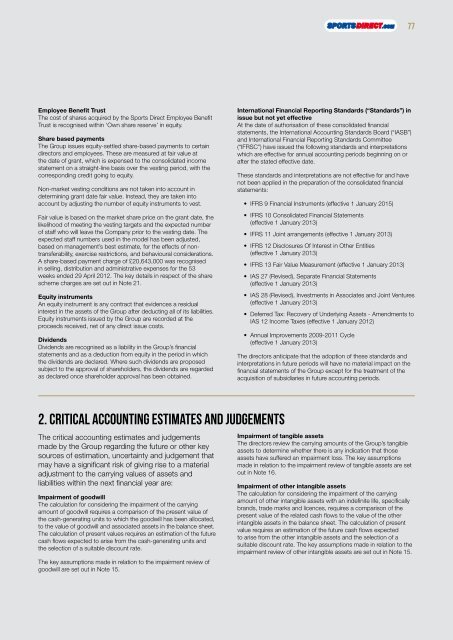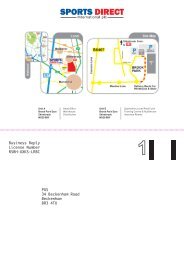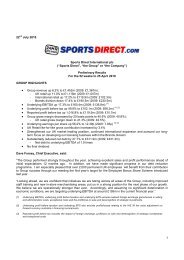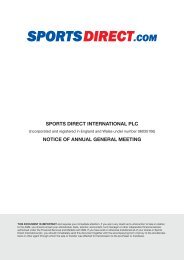Dave Forsey Chief Executive 19 July 2012 - Sports Direct International
Dave Forsey Chief Executive 19 July 2012 - Sports Direct International
Dave Forsey Chief Executive 19 July 2012 - Sports Direct International
Create successful ePaper yourself
Turn your PDF publications into a flip-book with our unique Google optimized e-Paper software.
Employee Benefit Trust<br />
The cost of shares acquired by the <strong>Sports</strong> <strong>Direct</strong> Employee Benefit<br />
Trust is recognised within ‘Own share reserve’ in equity.<br />
Share based payments<br />
The Group issues equity-settled share-based payments to certain<br />
directors and employees. These are measured at fair value at<br />
the date of grant, which is expensed to the consolidated income<br />
statement on a straight-line basis over the vesting period, with the<br />
corresponding credit going to equity.<br />
Non-market vesting conditions are not taken into account in<br />
determining grant date fair value. Instead, they are taken into<br />
account by adjusting the number of equity instruments to vest.<br />
Fair value is based on the market share price on the grant date, the<br />
likelihood of meeting the vesting targets and the expected number<br />
of staff who will leave the Company prior to the vesting date. The<br />
expected staff numbers used in the model has been adjusted,<br />
based on management’s best estimate, for the effects of nontransferability,<br />
exercise restrictions, and behavioural considerations.<br />
A share-based payment charge of £20,643,000 was recognised<br />
in selling, distribution and administrative expenses for the 53<br />
weeks ended 29 April <strong>2012</strong>. The key details in respect of the share<br />
scheme charges are set out in Note 21.<br />
Equity instruments<br />
An equity instrument is any contract that evidences a residual<br />
interest in the assets of the Group after deducting all of its liabilities.<br />
Equity instruments issued by the Group are recorded at the<br />
proceeds received, net of any direct issue costs.<br />
Dividends<br />
Dividends are recognised as a liability in the Group’s financial<br />
statements and as a deduction from equity in the period in which<br />
the dividends are declared. Where such dividends are proposed<br />
subject to the approval of shareholders, the dividends are regarded<br />
as declared once shareholder approval has been obtained.<br />
2. Critical accounting estimates and judgements<br />
The critical accounting estimates and judgements<br />
made by the Group regarding the future or other key<br />
sources of estimation, uncertainty and judgement that<br />
may have a significant risk of giving rise to a material<br />
adjustment to the carrying values of assets and<br />
liabilities within the next financial year are:<br />
Impairment of goodwill<br />
The calculation for considering the impairment of the carrying<br />
amount of goodwill requires a comparison of the present value of<br />
the cash-generating units to which the goodwill has been allocated,<br />
to the value of goodwill and associated assets in the balance sheet.<br />
The calculation of present values requires an estimation of the future<br />
cash flows expected to arise from the cash-generating units and<br />
the selection of a suitable discount rate.<br />
The key assumptions made in relation to the impairment review of<br />
goodwill are set out in Note 15.<br />
<strong>International</strong> Financial Reporting Standards (“Standards”) in<br />
issue but not yet effective<br />
At the date of authorisation of these consolidated financial<br />
statements, the <strong>International</strong> Accounting Standards Board (“IASB”)<br />
and <strong>International</strong> Financial Reporting Standards Committee<br />
(“IFRSC”) have issued the following standards and interpretations<br />
which are effective for annual accounting periods beginning on or<br />
after the stated effective date.<br />
These standards and interpretations are not effective for and have<br />
not been applied in the preparation of the consolidated financial<br />
statements:<br />
• IFRS 9 Financial Instruments (effective 1 January 2015)<br />
• IFRS 10 Consolidated Financial Statements<br />
(effective 1 January 2013)<br />
• IFRS 11 Joint arrangements (effective 1 January 2013)<br />
• IFRS 12 Disclosures Of Interest in Other Entities<br />
(effective 1 January 2013)<br />
• IFRS 13 Fair Value Measurement (effective 1 January 2013)<br />
• IAS 27 (Revised), Separate Financial Statements<br />
(effective 1 January 2013)<br />
• IAS 28 (Revised), Investments in Associates and Joint Ventures<br />
(effective 1 January 2013)<br />
• Deferred Tax: Recovery of Underlying Assets - Amendments to<br />
IAS 12 Income Taxes (effective 1 January <strong>2012</strong>)<br />
• Annual Improvements 2009-2011 Cycle<br />
(effective 1 January 2013)<br />
The directors anticipate that the adoption of these standards and<br />
interpretations in future periods will have no material impact on the<br />
financial statements of the Group except for the treatment of the<br />
acquisition of subsidiaries in future accounting periods.<br />
Impairment of tangible assets<br />
The directors review the carrying amounts of the Group’s tangible<br />
assets to determine whether there is any indication that those<br />
assets have suffered an impairment loss. The key assumptions<br />
made in relation to the impairment review of tangible assets are set<br />
out in Note 16.<br />
Impairment of other intangible assets<br />
The calculation for considering the impairment of the carrying<br />
amount of other intangible assets with an indefinite life, specifically<br />
brands, trade marks and licences, requires a comparison of the<br />
present value of the related cash flows to the value of the other<br />
intangible assets in the balance sheet. The calculation of present<br />
value requires an estimation of the future cash flows expected<br />
to arise from the other intangible assets and the selection of a<br />
suitable discount rate. The key assumptions made in relation to the<br />
impairment review of other intangible assets are set out in Note 15.<br />
77



![Our ref: [ ] - Sports Direct International](https://img.yumpu.com/19248141/1/184x260/our-ref-sports-direct-international.jpg?quality=85)





![Our ref: [ ] - Sports Direct International](https://img.yumpu.com/18440214/1/184x260/our-ref-sports-direct-international.jpg?quality=85)

